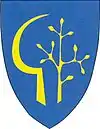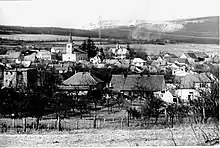Bohutice
Bohutice is a village and municipality (obec) in Znojmo District in the South Moravian Region of the Czech Republic.
Bohutice | |
|---|---|
Municipality | |
 Flag  Coat of arms | |
 Bohutice | |
| Coordinates: 48°59′26″N 16°21′23″E | |
| Country | |
| Region | South Moravian |
| District | Znojmo |
| Area | |
| • Total | 7.16 km2 (2.76 sq mi) |
| Elevation | 258 m (846 ft) |
| Population (2006) | |
| • Total | 615 |
| • Density | 86/km2 (220/sq mi) |
| Postal code | 671 76 to 672 01 |
Geographical Situation
Bohutice lies approx. 30 km North of the Austrian border.
The municipality covers an area of 7.16 square kilometres (2.76 sq mi), and has a population of 615 (as at 3 July 2006).
Bohutice lies approximately 29 kilometres (18 mi) north-east of Znojmo, 30 km (19 mi) south-west of Brno, and 186 km (116 mi) south-east of Prague.
The village lies on the former royal and imperial railway line at the kilometre 114,1, this railway line went from Brno to Vienna East Station (Wien Ostbahnhof).

History
The first documentary mention of Bohutice (Bochtitz or Pochtitz) stems from 1253 mentioning a parish church. At the beginning of the 14th century, the village belonged to the Vyšehradská kapitola near Prague.
In 1321, Jindřich z Lipé (Heinrich von Leipa on Kromau) procured Bohutice for 2,000 mark.
From 1346 to 1356, Bohutice belonged to its feudal lord who was called Voytel of Bohutice (von Bochtitz) and to Miksik von Geiwic. In 1346, Miksik von Geiwic (Mikšík z Kyjovic) sold Bochtitz to the land commander Stibor Pflug and to the pastor of Hosterlitz, Berchtold, for 62 marks and 12 groschen. In 1448, Racek ze Zborovic (von Zborowitz) claimed his ownership of Bochtitz.
In 1491 and 1500, Georg Kussy von Mukodiel owned the estate.
In 1535, the Bohemian Marshal Johann von Leipa sold his share of the fort Bochtitz to Jan Kusý z Mukoděl (Johann Kussy von Mukodiel). Jan was followed by his son Mathias around 1542.
In 1545, the Anabaptists settled in the village with his permission. In 1560, the village became possession of Stephan Kussy von Mukodiel, who in 1576 passed his estate to his son Wilhelm. Wilhelm was followed by Jan (gen. Hanuss) Kussy von Mukodiel, who on April 14, 1597 drove the Anabaptists out of their farm and estate and disowned them from the propert. However, the Anabaptists returned to their farm and estate after just one year.
The evangelical church was built in 1615 and dedicated to all Angels. On August 1, 1619, the village was burned down entirely by General Dampierre's mercenaries. Hanuss' sons Stephan and Wilhelm lost Bochtitz due to participation in the uprising of 1620 after the Battle on White Hill near Prague.
At the end of 1620, the Landlord of Bohutice was an imperial lieutenant named Michael von Althan.
On 26 August 1621, the Preacher Of The Word (elected in 1610), Konrad Blösi, died in Bochtitz.
On January 5, 1622, the village was looted and the house of the Anabaptists set on fire, the Anabaptists were finally expelled.
On September 25th 1627, the King Ferdinand II gave the little castle and village of Bochtitz to the Znojmo Jesuit College, which on March 10, 1673 also bought the village of Babitz with a farm, sheepfold, tavern, orchards and hop gardens for 4075 Rhein florins. The church behind the village had been neglected since 1657. The oldest register of inhabitants dates from 1641, in which 39 families are listed. In 1663, the Jesuit college had repaired the small church on the hill behind the cemetery, so that in 1664 holy masses were celebrated there.
After the Order was disbanded by the imperator on July 21, 1773, the church was desecrated and the cemetery chapel was built instead. On the site of the church windmills were built, but sod and demolished in 1850 due to frequent storm damages.
In 1785, the village school was founded, in 1807 it was attended by 70 children. The property was transferred to the Study Fund, and on October 15th 1789 it was let over to Johann Topolansky for annual interest of 7508 Florenos on a long-term lease.
In 1803, there was a brewery and a fabric factory in Bohutice. After Topolansky's death, his widow Theresia married Václav Petříček (Wenceslaus Petritschek), who owned the estate after her death on December 31 1804. He could make compromise with the other heirs on July 15 1805 and became the only owner of Bohutice. After his death on June 22 1825, his daughter Aloisia Petritschek inherited the village. She then married the administrator of her property Josef Seydl.
From 1840-1850, coal was mined in Bochtitz.
On December 3 1866, Aloisia Seydl was confirmed by the Financial Procurator as the legal possessor of Bochtitz. The marriage contract of December 14, 1869 gave Josef Seydl half of the Bochtitz estate.
In 1867 the parish office was established in Bochtitz and the building of the new church began. The Assumption Church of Holy Mary was completed and consecrated in 1870. It had 4 bells, the Virgin Mary, St. Wenceslas, St. Michael and St. Joseph. The estate's owner Josef Seydl and his wife Aloisia financed the construction of the church.
The railway came to Bochtitz in 1868.
The school library was founded in 1876 by Josef Seydl, who dedicated 76 books. Josef Seydl died in 1878 and after his death the estate was worth 82 792 Rhein Guilder. Heinrich Seydl got 1/6 of ownership of the Bochtitz estate, 2/6 went to Karl Seydl, 1/6 became property of Rosalia Seydl, 1/6 went to Obsieger Maria and 1/6 to Henriette Mauer.
The year 1889 was the year of foundation of the Volunteer Fire Brigade.
A new school building was built in 1907.
In 1909, Anna Seydl became the owner of 5 shares of the estate, while Rosalia Seydl kept on her own share. Thus, the two sisters were co-owners of the estate and the village.
In 1910, the gymnastics club Sokol was founded. On July 8 1923, the Sokol club house was opened. On August 23 1925, another club house was opened by the gymnastics club Orli (The Eagles).
On December 31 1928, the electric lighting came to the village.
On June 25 1935, a new Protestant church opened.
The last estate owner was Hans Seydl-Neuschl. He was adopted by the Anna Seydl who had no children of her own. He was natively from Nový Přerov (Neu Prerau) near Mikulov. Hans Neuschl adopted the last name of his foster mother. During the protectorate he was the village administrator. After 1945 he was expelled from his estate as a Sudeten German. As former collaborateur of Nazi Germans, he was allowed to bring along max. 50kg of his possessions. The rest was supposed to be left behind. After 2 years of Czechoslovak Republic, the socialist dictatorship was established February 1948. With the socialism came the disappropriation of the farmers, during the 1950s. The local Agricultural Production Cooperative was founded on March 1st 1957.
In 1966, the public water supply was established. The waste water system had to wait until 2018.
Sightseeings & Points Of Interest
The most important historical buildings in the village are the Bochutice Castle and the Assumption Church of Saint Mary. In the castle, there is an exhibition of wooden statues depicting the Stations of the Cross connected to last Jesus Christ's way to the Golgota hill. This exhibition, as well as the three castle cellars that are located in the courtyard, were created through the tireless efforts for the village of the former mayor Pavel Štefka.
Behind the village, there is a pilgrimage site that represents the grotto of Lourdes. It was created from the plans of Pastor Antonín Prášek and was inaugurated on July 22, 1928. There are 3 Stations of the Cross on the was from the grotto to the cemetery, this Way of the Cross was also created by Pastor Prášek. His plan was to set up 13 Stations of the Cross, but this plan was interrupted forever by World War II and then by the socialist regime.
A statue of St. Michael stands on the Michálek (formerly called Steinhübl) in the middle of the vineyards southwest of the center of the village. The Michálek is a nature reserve. In the vicinity of the village there are baroque statues of St. John, St. Michael, St. Florian and St. Wenceslaw. One of the statues stands behind the cemetery at the former path leading to the church on the hill behind the village. In the middle of the cemetery, there is a chapel which served as a replacement church until 1870. It was meant to be the family crypt of the Seydl family.
Yearly Events Held In Bohutice
One of the highlights of social life in Bohutice is the yearly held wine tasting that takes place at the end of April. The local winegrowers exhibit their wines and the visitors have the chance to taste them as much as they want to. In the castle cellar, several guided wine tastings take place, ending up in opening champagne bottles with a sabre. Another drinks and meals from the local production are being served at numerous stands. It is the mostly attended event during the year in the village.
The Bohutice Apricot Competition (Bohutická meruňka) takes place in the summer (July). During this event, the hobby distillers of Slivovitz are tasting the results of their work. This competition ends in awarding the distiller of the best tasting Meruňkovice. (Meruňkovice is a clear alcoholic beverage made by distillation of the apricots, a local kind of Apricot brandy). During this apricot fair also an Apricot Marmalade Competition takes place, the best marmalade lady cook is rewarded with valuable prize.
Folkloric dance events are held twice a year. In May it's called "Pout'" and in September it's called "Hody". The highlight of these dance events are the couples' dances under the decorated tree (called Mája). The participants sing folk songs and wear traditional costumes. A brass band plays polka and waltz tunes.
In October, the Bohutice Autumn Fair takes place. Here you can feast and savour the meals from local freshly slaughtered pigs, you can drink the Federweisser (freshly made wine) from the local vineyards. Also, local wines and honey wines are offered to the thirsty visitors. The agenda is full of entertainments for adults and children. One can watch fencing duels, performance of jugglers and see examples of old crafts. Furthermore, one can watch the blacksmith producing new hoofs as well as other traditional crafts.
References
- Czech Statistical Office: Municipalities of Znojmo District
- Michael Vaňáček - Bohutice (published in Brno 1967)
- Gregor Wolny - Süd Mähren Bd. 3 - Znaimer Kreis pages 92-93 (published in Brünn 1837)
- Vilém Haňák - Vlastivěda moravská pp. 132-141 (published in Brno 1913)
- gameo.org - Bohutice, https://gameo.org/index.php?title=Bohutice_(Jihomoravsk%C3%BD_kraj,_Czech_Republic)
| Wikimedia Commons has media related to Bohutice. |
Famous People Coming From Bohutice
- Konrad Blösi - in 1610 appointed Preacher Of The Word (famous anabaptist), died on August 26 1621 in Bohutice
- Max Rabl (1898–1964), Austrian Politician
- Antonín Prášek (1886-1959) - Pastor of Bohutice, builder of the Loudes Grotto and the Stations of the Cross